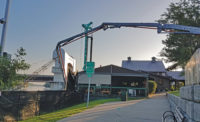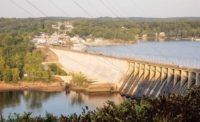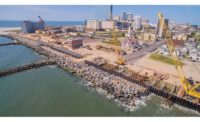City of Troy Seawall Stabilization | Submitted by CHA Consulting Inc.
Troy, N.Y.
Region: ENR New York
Specialty Construction
OWNER: City of Troy
LEAD DESIGN FIRM, CIVIL ENGINEER: CHA Consulting Inc.
GENERAL CONTRACTOR: C.D. Perry & Sons Inc.
The almost century-old seawall lining the banks of the Hudson River along its path through Troy, N.Y., was in need of repair after sustaining damage during Hurricane Irene.
“Preconstruction surveys indicated rotational movement of the existing seawall, which posed a potential for failure of sections of the wall,” says Michael Miller, vice president at CHA Consulting Inc., lead design and civil engineering firm on the project. Also in need of protection was a county wastewater sewer interceptor located just behind the wall and eroding riverbank, which created the potential for discharge into the river.
The solution—which included concrete repairs, a new precast concrete panel system with steel piles and tiebacks drilled into bedrock, and 1,000 ft of raised wall—would address not only stabilization but also resilience against future elevated flood risks to protect the businesses and structures along the seawall. The marina’s docks and dock master building were made to “float in accordance with the changing river conditions. These systems can now rise to the level of the 100-year flood event,” says Miller. Nearby parking lots and buildings are protected against a 10-year-flood event.
Water levels were not just a concern for the future. Because there were so many buildings on the land side of the wall, and its setting within a historic district, crews performed much of the work on barges in the river. Drill rigs had about four hours a day to work within a regularly changing schedule that took into account the tidal cycle and weather-related changes to river elevation.
CHA Consulting coordinated closely with GC C.D. Perry and Sons Inc. and subcontractors on efforts such as underwater inspection for sub-water-line repairs, tieback pretensioning and health and safety protocols that led to no accident-related lost time or recordable incidents.






Post a comment to this article
Report Abusive Comment